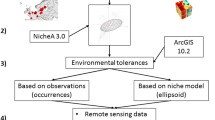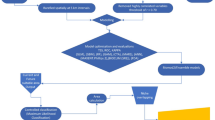Abstract
Sedimentary and water column evidence from 45 boat-accessible and eight backcountry lakes was used to investigate the distribution of Bythotrephes longimanus in northeast Minnesota, USA, and adjacent Ontario, Canada. The results expand the documented range of Bythotrephes in Minnesota from Lake Superior, Island Lake, and Saganaga Lake to Flour Lake, Greenwood Lake, McFarland Lake, Pine Lake, and Caribou Lake as well as to Saganagons Lake in Ontario. The latter three lakes are located in roadless landscapes without motorized boat access. Results confirm that Bythotrephes is no longer present in Boulder Lake or Fish Lake (St. Louis County, Minnesota), providing the first evidence of range compression (extinction following introduction) of this species in North America. Distributional expansion was confined to a corridor along the international border between northeast Minnesota and Ontario. Lakes along the invasion corridor were deeper, more transparent, and had lower chlorophyll concentration, on average, compared to other lakes studied. The pattern of range expansion provided an opportunity to test the predictions of a forecasting model for Bythotrephes occurrence (MacIsaac et al. 2000 Archiv für Hydrobiologie 149: 1–21) based on habitat characteristics. The model predicted 51% of the surveyed inland lakes to be susceptible to invasion, however, only 13% were actually invaded, implying strong dispersal constraints. Application of the forecasting model to a broader set of 179 Minnesota lakes predicted that 41% may be vulnerable to establishment by Bythotrephes based on habitat characteristics, offering an estimate of the state’s overall lake susceptibility (i.e., fundamental niche) to invasion. The results of this study provide evidence for the importance of a low-light refuge where Bythotrephes can minimize vulnerability to fish predation as a key habitat feature not considered by the forecasting model.
Similar content being viewed by others
References
DR Barnhisel, The caudal appendage of the cladoceran Bythotrephes cederstroemi as defense against young fish. Journal of Plankton Research 13 (1991) 529-537
DJ Berg, DW Garton, HJ MacIsaac, VE Panov and IV Telesh, Changes in genetic structure of North American Bythotrephes populations following the invasion from Lake Ladoga, Russia. Freshwater Biology 47 (2002) 275-282
ME Brown and DK Branstrator, A 2001 survey of crustacean zooplankton in the western arm of Lake Superior. Journal of Great Lakes Research 30 (2004) 1-8
ME Brown and DK Branstrator, Seasonal dynamics of Bythotrephes diapausing egg emergence and production, and the role of dormancy in range expansion. Proceedings of the International Association of Theoretical and Applied Limnology 29 (2005) 174-178
MG Cohen and JB Shurin, Scale-dependence and mechanisms of dispersal in freshwater zooplankton. Oikos 103 (2003) 603-617
JHC Coulas, HJ MacIsaac and W Dunlop, Selective predation on an introduced zooplankter (Bythotrephes cederstroemi) by lake herring (Coregonus artedii) in Harp Lake, Ontario. Freshwater Biology 40 (1998) 343-355
KI Cullis and GE Johnson, First evidence of the cladoceran Bythotrephes cederstroemi Schoedler in Lake Superior. Journal of Great Lakes Research 14 (1988) 524-525
MR Forman and MC Whiteside, Occurrence of Bythotrephes cederstroemi in inland lakes in northeastern Minnesota as indicated from sediment records. Proceedings of the International Association of Theoretical and Applied Limnology 27 (2000) 1552-1555
Gravelle J (1990) Slimy species sneaks into inland lake. Duluth News Tribune, Duluth, MN, September 13
RI Hall and ND Yan, Comparing annual population growth estimates of the exotic invader Bythotrephes by using sediment and plankton records. Limnology and Oceanography 42 (1997) 112-120
JE Havel and JB Shurin, Mechanisms, effects, and scales of dispersal in freshwater zooplankton. Limnology and Oceanography 49 (2004) 1229-1238
ST Jarnagin, WC Kerfoot and BK Swan, Zooplankton life cycles: direct documentation of pelagic births and deaths relative to diapausing egg production. Limnology and Oceanography 49 (2004) 1317-1332
ST Jarnagin, BK Swan and WC Kerfoot, Fish as vectors in the dispersal of Bythotrephes cederstroemi: diapausing eggs survive passage through the gut. Freshwater Biology 43 (2000) 579-589
DG Jenkins and AL Buikema Jr, Do similar communities develop in similar sites? A test with zooplankton structure and function. Ecological Monographs 63 (1998) 421-443
OE Johannsson, EL Mills and R O’Gorman, Changes in the nearshore and offshore zooplankton communities in Lake Ontario: 1981–1988. Canadian Journal of Fisheries and Aquatic Sciences 48 (1991) 1546-1557
TJ Keilty, A new biological marker layer in the sediments of the Great Lakes: Bythotrephes cederstroemi (Schödler) spines. Journal of Great Lakes Research 14 (1988) 369-371
JP Koenings and JA Edmundson, Secchi disk and photometer estimates of light regimes in Alaskan lakes: effects of yellow color and turbidity. Limnology and Oceanography 36 (1991) 91-105
Kuchera S (2003) Invasive spiny waterflea found in Lake Saganaga. Duluth News Tribune, Duluth. MN, October 3
JT Lehman and CE Cáceres, Food-web responses to species invasion by a predatory invertebrate: Bythotrephes in Lake Michigan. Limnology and Oceanography 38 (1993) 879-891
HJ MacIsaac, JVM Borbely, JR Muirhead and PA Graniero, Backcasting and forecasting biological invasions of inland lakes. Ecological Applications 14 (2004) 773-783
HJ MacIsaac, HAM Ketelaars, IA Grigorovich, CW Ramcharan and ND Yan, Modeling Bythotrephes longimanus invasions in the Great Lakes basin based on its European distribution. Archiv für Hydrobiologie 149 (2000) 1-21
A Palmer, HB Stich and G Maier, Distribution patterns and predation risk of the coexisting cladocerans Bythotrephes longimanus and Leptodora kindtii in a large lake – Lake Constance. Hydrobiologia 442 (2001) 301-307
JB Shurin, Dispersal limitation, invasion resistance, and the structure of pond zooplankton communities. Ecology 81 (2000) 3074-3086
WG Sprules, HP Riessen and EH Jin, Dynamics of the Bythotrephes invasion of the St. Lawrence Great Lakes.. Journal of Great Lakes Research 16 (1990) 346-351
TW Therriault, IA Grigorovich, ME Cristescu, HAM Ketelaars, M Viljanen, DD Heath and HJ MacIsaac, Taxonomic resolution of the genus Bythotrephes Leydig using molecular markers and re-evaluation of its global distribution. Diversity and Distributions 8 (2002) 67-84
MJ Vander Zanden, KA Wilson, JM Casselman and ND Yan, Species introductions and their impacts in North American Boreal Shield lakes. In: JM Gunn, RJ Steedman and RA Ryder (eds.) Boreal Shield Watersheds: Lake Trout Ecosystems in a Changing Environment.. Boca Raton: CRC Press (2004) pp. 239-263
M Williamson and A Fitter, The varying success of invaders. Ecology 77 (1996) 1661-1666
ND Yan, A Blukacz, WG Sprules, PK Kindy, D Hackett, RE Girard and BJ Clark, Changes in zooplankton and the phenology of the spiny water flea, Bythotrephes, following its invasion of Harp Lake, Ontario, Canada. Canadian Journal of Fisheries and Aquatic Sciences 58 (2001) 2341-2350
ND Yan, WI Dunlop, TW Pawson and LE MacKay, Bythotrephes cederstroemi (Schoedler) in Muskoka lakes: first records of the European invader in inland lakes in Canada. Canadian Journal of Fisheries and Aquatic Sciences 49 (1992) 422-426
ND Yan, R Girard and S Boudreau, An introduced invertebrate predator (Bythotrephes) reduces zooplankton species richness. Ecology Letters 5 (2002) 481-485
PM Yurista, Bythotrephes cederstroemi diapausing egg distribution and abundance in Lake Michigan and the environmental cues for breaking diapause. Journal of Great Lakes Research 23 (1997) 202-209
Author information
Authors and Affiliations
Corresponding author
Rights and permissions
About this article
Cite this article
Branstrator, D.K., Brown, M.E., Shannon, L.J. et al. Range Expansion of Bythotrephes longimanus in North America: Evaluating Habitat Characteristics in the Spread of an Exotic Zooplankter. Biol Invasions 8, 1367–1379 (2006). https://doi.org/10.1007/s10530-005-5278-7
Received:
Accepted:
Published:
Issue Date:
DOI: https://doi.org/10.1007/s10530-005-5278-7




